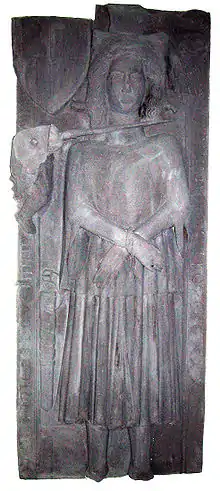Armleder persecutions
The Armleder persecutions were a series of massacres against Jews in Franconia and Alsace in 1336–1339.[1]
| Part of a series on |
| Antisemitism |
|---|
 |
|
|
History

In 1336 a nobleman of Franconia, Arnold von Uissigheim, claiming that an angel had commissioned him to do so, gathered a band of marauders and pillaged and murdered the Jews. These assassins styled themselves Judenschläger (Jewbeaters). Somewhat later John Zimberlin, an innkeeper of Upper Alsace, followed the example set in Franconia. He tied pieces of leather round his arms and bade his followers do the same. This gave rise to the name Armleder ('arm leather'). Their leader was called King Armleder, and under him they marched through Alsace, massacring Jews in some 120 communities, including Rouffach, Ensisheim, Muelhausen, and Ribeauvillé.[1]
Those who were fortunate enough to escape fled to Colmar, where the citizens protected them. Armleder, whom success had intoxicated, besieged the city and devastated the surrounding country. The citizens asked Emperor Louis of Bavaria to assist them. When Armleder heard that the imperial troops were approaching, he fled to France. No sooner had the emperor left the country, however, than Armleder again appeared. The persecutions soon spread to Bavaria, Bohemia, Austria, Styria, and Carinthia.[2][3]
The lords of Alsace, under the leadership of the bishop of Strasburg, formed an alliance (May 17, 1338), the members of which pledged themselves to pursue Armleder and fifteen of his most prominent followers. But it was very difficult to attack Armleder's adherents; and in the following year a knight, Rudolph of Andlau, made an agreement with King Armleder, granting an amnesty to him and his followers, provided that for the next ten years they would refrain from molesting the Jews. Though attacks ceased for a short time, the Jews, during the ten years of armistice, never lived in security; and in 1349 there occurred the terrible massacres on the occasion of the Black Death, to which the attacks of Armleder had been the prelude.
References
![]() This article incorporates text from a publication now in the public domain: Gottheil, Richard; Deutsch, Gotthard (1902). "Armleder persecutions". In Singer, Isidore; et al. (eds.). The Jewish Encyclopedia. Vol. 2. New York: Funk & Wagnalls. p. 120.
This article incorporates text from a publication now in the public domain: Gottheil, Richard; Deutsch, Gotthard (1902). "Armleder persecutions". In Singer, Isidore; et al. (eds.). The Jewish Encyclopedia. Vol. 2. New York: Funk & Wagnalls. p. 120.
- Weill, Georges (2007). "Armleder". Encyclopaedia Judaica. Vol. 2. Detroit. pp. 476–477. ISBN 978-0-02-865930-5.
{{cite encyclopedia}}: CS1 maint: location missing publisher (link) - Roth, Norman (2014). "Germany". Medieval Jewish Civilization: An Encyclopedia. Taylor & Francis. pp. 299–300. ISBN 978-1-136-77155-2.
- Müller, Jörg R. (2004). "Ereẓ gezerah—'Land of Persecution': Pogroms against the Jews in the regnum Teutonicum from c. 1280 to 1350" (PDF). In Cluse, Christoph (ed.). The Jews of Europe in the Middle Ages (Tenth to Fifteenth Centuries): Proceedings of the International Symposium held at Speyer, 20–25 October 2002. Cultural Encounters in Late Antiquity and the Middle Ages. Vol. 4. Turnhout: Brepols. pp. 254–256.
Further reading
- Cluse, Christoph (1996). "Blut ist im Schuh. Ein Exempel zur Judenverfolgung des „Rex Armleder"". In Burgard, Friedhelm (ed.). Liber Amicorum necnon et amicarum für Alfred Heit (PDF) (in German). Trier. pp. 371–392.
{{cite book}}: CS1 maint: location missing publisher (link) - Mentgen, Gerd (1995). Studien zur Geschichte der Juden im mittelalterlichen Elsass (in German). Hannover. pp. 348–360.
{{cite book}}: CS1 maint: location missing publisher (link) - Lotter, Friedrich (1988). "Hostienfrevelvorwurf und Blutwunderfälschung bei den Judenverfolgungen von 1298 ('Rintfleisch') und 1336-1338 ('Armleder')" (PDF). Fälschungen im Mittelalter (in German). Hannover. 33 (5): 533–583.
- Arnold, Klaus (1974). "Die Armledererhebung in Franken 1336". Mainfränkisches Jahrbuch (in German). 26: 35–62.
- Hoyer, Siegfried (1965). "Die Armlederbewegung – ein Bauernaufstand 1336/1339". Zeitschrift für Geschichtswissenschaft (in German). 1: 74–89.
- Arnold, Klaus (1980). "Armledererhebung". Lexikon des Mittelalters (in German). Vol. 1. München: Artemis & Winkler. p. 983. ISBN 3-7608-8901-8.